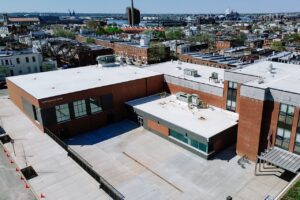 There is no better example of how strong schools create strong neighborhoods than in Canton. Hampstead Hill Academy (HHA) embodies a broader national trend in which high-performing public schools are reversing the traditional “suburban flight” pattern.
There is no better example of how strong schools create strong neighborhoods than in Canton. Hampstead Hill Academy (HHA) embodies a broader national trend in which high-performing public schools are reversing the traditional “suburban flight” pattern.
Cities like Baltimore, Washington, D.C., and Philadelphia are seeing more families choose to stay in urban areas, drawn by top-tier public education options. With schools like HHA continuing to deliver exceptional academic results, Canton remains a magnet for families who might have otherwise relocated to the suburbs.
Since the late 1990s, Baltimore’s Canton neighborhood has undergone a dramatic transformation. Once a gritty, working-class, and primarily industrial neighborhood, Canton has evolved into one of the city’s most vibrant and sought-after waterfront communities. This shift was driven by a combination of economic investment, urban renewal efforts, and demographic changes that turned the area into a hotspot for young professionals, families, and developers.
Canton in the Early 1990s: An Industrial Past
For much of the 20th century, Canton was a blue-collar, industrial neighborhood with a strong maritime and manufacturing presence. Home to shipyards, steel mills, and canning factories, the area was historically populated by European immigrant workers, primarily of Polish, German, and Irish descent. By the late 20th century, with deindustrialization, job losses, and the closure of major employers like Bethlehem Steel, commercial buildings and many homes were in disrepair, and large portions of the waterfront were underutilized or abandoned.
 Canton’s revival started in the early 1990s was fueled by:
Canton’s revival started in the early 1990s was fueled by:
- Waterfront Redevelopment: Inspired by Baltimore’s Inner Harbor, the city repurposed old factories into luxury apartments, retail spaces, and parks.
- Housing Boom: Young professionals restored historic rowhouses, while developers introduced high-end townhomes and condos.
- Commercial Growth: O’Donnell Square became a lively hub with bars, restaurants, and shops.
- Infrastructure Upgrades: Improved roads, lighting, green spaces, and expanded water taxi service enhanced accessibility.
Amid this wave of change, HHA has played a pivotal role in shaping the neighborhood’s future. In 1996, the Baltimore Curriculum Project (BCP) partnered with HHA to become a neighborhood conversion charter school. The academic and cultural transformation from the former Hampstead Hill Elementary School #47 to the highly reputable HHA is one of great pride in the Canton community and across the state.
2000s: A Fully Transformed Neighborhood
 By the early 2000s, Canton had completed its shift from an aging industrial district to one of Baltimore’s most desirable neighborhoods. Home values soared, rising by more than 100%, and the population became more diverse, with an influx of young professionals, entrepreneurs, and families.
By the early 2000s, Canton had completed its shift from an aging industrial district to one of Baltimore’s most desirable neighborhoods. Home values soared, rising by more than 100%, and the population became more diverse, with an influx of young professionals, entrepreneurs, and families.
With the introduction of Maryland’s charter school law in 2003, HHA became one of Baltimore City’s first conversion charter schools. Under the leadership of Principal Matt Hornbeck, who has served for over two decades, HHA has consistently ranked as the top-performing public school in the city. Its elementary program stands in the 87th percentile statewide, while its middle school ranks in the 97th percentile.
Traditionally, Baltimore families moved to the suburbs once their children reached school age, seeking better education and more space. But HHA has changed the equation. With its rigorous academics, engaged community, and reputation for excellence, the school has become a compelling reason for families to stay in the city.
 Canton has also cultivated a strong, family-friendly atmosphere. Many HHA parents are actively involved in the school community, participating in events, fundraisers, and neighborhood initiatives. This deep sense of connection makes urban living even more appealing for families.
Canton has also cultivated a strong, family-friendly atmosphere. Many HHA parents are actively involved in the school community, participating in events, fundraisers, and neighborhood initiatives. This deep sense of connection makes urban living even more appealing for families.
Continuing to Grow with the Neighborhood
HHA continues to adapt and grow alongside Canton, responding to the needs of the community. The school recently opened the Newstead Gym, a much-anticipated building addition that provides students and the broader community with new opportunities for athletics, assemblies, and large-scale events. This facility reflects the school’s commitment to meeting the evolving needs of its students while serving as a community anchor.
